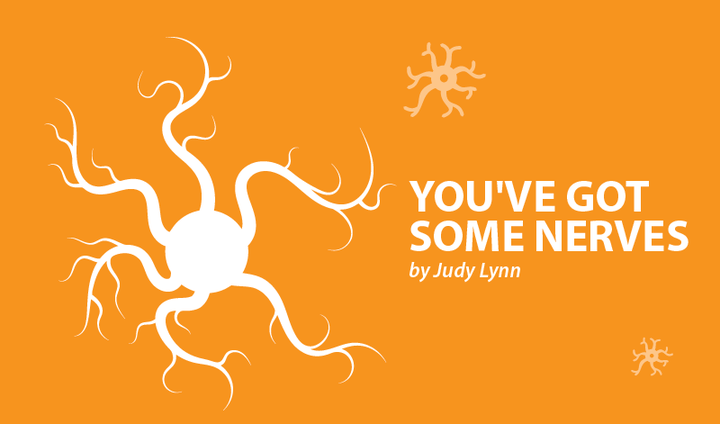Free Your Fascia!
Written by |


One of the most frustrating aspects of my MS is a frequent feeling of tightness and pain. The sensations may be in my arms, legs, or even in the trunk of my body in the form of the “MS hug.” Gabapentin helps to keep the pain at a tolerable level, but it’s rarely entirely absent. I describe the tightness as a feeling of thick rubber bands pulling between various parts of my body. Discussions with my massage therapist led me to suspect that some of this pain may be because of tight fascia, rather than muscles.
Dr. Christiane Northrup explains that fascia is “made up of densely packed collagen fibers that wrap around each of your internal organs and connect them to your muscles and bones. It is responsible for stabilizing your entire body and giving you your human form.” It is often compared to a cobweb holding your organs, ligaments, and muscles in place.
Fascia can tighten and form adhesions to muscles or ligaments. When you move, the fascia may squeeze nerves and vessels, creating pain or discomfort. During my massage therapy, I learned that some of my discomfort was referred pain. This means that pain is felt at a site other than the place of injury. For example, the massage therapist may apply pressure to my trapezoid and I feel a pain in my wrist. Referred pain is complicated and generally thought of as the body misinterpreting where pain signals are coming from. If we think about the notion of fascia as a web, it is easy to visualize how pressing on one part of a web may cause other parts to stretch, pull or twist. If there are areas where the fascia is stuck, then the tug on the fascia around my shoulder may cause an adhesion to squeeze or irritate nerves in my wrist.
What can you do to keep your fascia flexible?
In “A Body Part You Never Knew You Had Could Be Making You Miserable,” by Corrie Pikul, experts give several suggestions:
- Hydrate. This helps keep the tissue lubricated and pliable.
- Move frequently. Don’t sit in one place too long as this can cause fascia and muscles to get stuck in one position.
- Stretch gently. Try stretching your arms and legs out and gently rolling from side to side before you get out of bed in the morning.
- Use a foam roller. If you haven’t used one of these before, a physical therapist, massage therapist, or physiatrist can help you learn how to use it correctly. Fair warning: These are definitely a no-pain, no-gain endeavor.
- Warm up before you exercise. Do some range of motion or dynamic stretching, such as arm swings and shoulder rolls before you begin.
- Try massage. Ask your practitioner to work on releasing your fascia. Rolfing is one type of massage focused on fascia and connective tissue.
- Check out the Fasciablaster. This is relatively new on the market and costs around $90.
I put the Fasciablaster on my Christmas list. The price may seem steep at first glance, but it is no more than the cost of a 90-minute massage. My health insurance covers massage for acute injury, but does not cover for chronic conditions like MS despite evidence of pain relief. There appears to be surprisingly little in the medical literature specific to MS and fascia. I’m curious about the connections. Does the MS hug have anything to do with fascia? Are people with MS prone to more constricted fascia, and if so, why? Do any medications or supplements help? Are patients being prescribed medications like baclofen, when the source of tightness is fascia rather than muscle?
I have high hopes that the “blaster” will let me stretch out the time between massage visits. My plan B is to bravely try Rolfing. Perhaps as my web is straightened out, it can pull it a little more from top to bottom, so that I gain 2 inches in height and lose 2 around the middle! In the meantime, let me know if you’ve had any luck relieving myofascial pain.
***
Note: Multiple Sclerosis News Today is strictly a news and information website about the disease. It does not provide medical advice, diagnosis, or treatment. This content is not intended to be a substitute for professional medical advice, diagnosis, or treatment. Always seek the advice of your physician or other qualified health provider with any questions you may have regarding a medical condition. Never disregard professional medical advice or delay in seeking it because of something you have read on this website. The opinions expressed in this column are not those of Multiple Sclerosis News Today or its parent company, Bionews Services, and are intended to spark discussion about issues pertaining to multiple sclerosis.






Teresa Barr
I moved from Orlando where a regularity saw someone trained in Facia release- great pain reliever. - this was before my MS diagnosis.
Just found someone in NJ who is trained and she even got my "foot" to release- improved my walking. I see her each week for 30 minutes - you do not want to over do- could irritate nerves.
Judy Lynn
Thank you, Teresa! Excellent point on being careful not to overdo it. I may want to do more frequent 30 minute sessions, rather than the 60-90 every few weeks.
Connie
Teresa, Where in NJ did you find the trained therapist?
I am from NJ and have MS. I would love a consult with this person.
Ann Zabaldo
Great article! I've been seeing a fascial expert for the last year+ to deal w/ my pain level from MS. Grateful a friend recommended this therapy!
If you are interested in learning more about how the fascia web works I recommend Phil Tavolacci's book WHAT'S IN YOUR WEB? Tavolacci is a Physical Therapist and author who studied and continues to study w/ the originator of myofascial release, John F. Barnes. Tavolacci is also my myofascial release therapist. And I recommend him for that, too!
Thanks for starting this discussion. I look forward to hearing from more people about their experience w/ myofascial release.
Ann Z
Washington, DC
Judy Lynn
Thank you, Ann. I will definitely check out the book! I am hopeful that this path may lead to less pain.
jacqueline
Check out the MS Gym. This is part of every daily workout
Judy Lynn
Thanks for the tip!
inge Freeth
With sometimes 'fascia-problems',my personal trainer thought me some stretch exercises, they make a big difference in relief, more than any massage will do. So whenever i have problems, i first do these exercises and they still work.
(Wrist and elbow pain is relieved by some simple schoulderstreches for example)
keep on going strong, greets Inge.
Judy Lynn
Thanks, Inge!! Proper stretching is so important and much easier to do regularly than get a massage.
Sue Jones
Thank you sooooooooo much for this piece of info. Not sure if this is available locally but will be looking forward to help me after Xmas. What you are saying makes total sense to me. Thanks again. Sue
Teresa Barr
My Therapist cautions not to use a Foam roller or the Faciablaster if you have MS ; she warns they are too severe.
For More info about Facia release go to wwwstretchtowin.com
Judy Lynn
Teresa- good point, for some people these may be too intense. Always listen to your body, and check with your healthcare provider when in doubt!
Sarah
Rolfing is incredible! Its helped me so much and I'm only 3 sessions in, theres 10 all together. I cant wait to see how much relief I get after I complete all 10 sessions.
Judy Lynn
Thanks for sharing, Sarah! That's fantastic to hear and you've inspired me to do some more research on rolfing and MS.
Mary Papastergos
Hi Sarah, how did you go after the 10 sessions and what improvements did you have?? :)
Karen
Realllly excited to explore this! Will be searching for providers PDQ !!!
Allison
Mu Acupuncturist does cupping on a problematic area and it works wonders.
Judy Lynn
I had a massage therapist that did cupping and I found it helpful, but I did bruise from it.
Elke Schmitt
You should also check out Mitochondria dysfunction. If your nerves, tendons, ligaments and muscles don't get the proper nourishment they become tight, loose their elasticity. My fathers fingers became so tight almost like a he was making a fist, he was 40 yrs old when that happened. Good doctor to listen to is a Dr. Alan Mandell, his you tube channel is motivationaldoc.com. Excellent Info. Also he recommends D-ribose sugar, that is what the mitochandria need, amongst other nutrients. Logical conclusion, when things go wrong on the cellular level everything thereafter suffers greatly, all of your organs, nervous system, etc.
Judy Lynn
Thank you, Elke, I'm not familiar with mitochondrial dysfunction but I will be sure to check it out!
Karen
Along these lines look into Dr Terry Wahls TED talk “Mind Your Mitochindria”. She RESOLVED her MS through diet, as did I. My story is in my bio www.livesetfree.com. Anything else is just chasing symptoms. If you keep eating the things that are irritating your blood chemistry everyday, nothing will be able to get on top of it. Must change your diet, figure out what your blood chemistry wants. Highly recommend Dr. Terry Wahls’ work.
Karen
Also want to share that once my MS symptoms vanished from changing my diet, I was able to heal my nervous system with Rolfing (I also ave scoliosis). I could NEVER have tolerated Rolfing with MS. I ended up having 42 sessions and it made me a new person!
Michelle
Thx for sharing!!! I know I need to improve my diet!!
Kelly
So neat! I've always had a thing for mitochondria*=) Thanks for posting this resource and sharing your Dad's story <3
Robyn
PLRASE do follow up with your report on how the FasciaBlaster is working for you. Thanks!
Richard Marcell
My fascia must be twisted and then the twists must be twisted up in inner twists because I can't believe what's going on with my body. I've had MS for 28 years, just retired a month ago and think I'm finally relaxing because after 2 massages which resulted in major myofascial releases, I've found my body going into self-induced myofascial release mode every evening, usually around 3:30 or so in the morning after I've had 6 or so hours sleep (I go to bed between 9 and 10pm). Sometimes lasts more than 1/2 hour, travels all over. Not sure where it will end.
Kelly
This is a great article! As a connective tissue specialist I am thrilled to see this information being so easy to access. You did an excellent job of explaining what can be a complicated topic. Thanks for taking the time to share this*
KT
Very helpful! Thank u! Wanted to share the MITO food plan from Functional Medicine. My DR (who also has MS) treats hers this way. Designed to feed mitochondria to battle MS fatigue. No new symptoms in the 3+ years I’ve been eating that way. You can print the plan & recipes free online. ?
Teresa
I've been foam rolling before and after exercise to increase blood flow to the areas where I have myofascial stickiness. It seems to be helping. But as others have said, it's important to not overdo it - you can get a rebound effect where tightening increases.